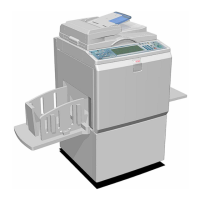PRINTING AND PRESSURE CYLINDER
C262/C265 6-100 SM
6.9 PRINTING AND PRESSURE CYLINDER
6.9.1 OVERVIEW
This model uses a pressure cylinder, instead of a press roller.
Two printing pressure springs [A] (one each at front and rear) pull the pressure
cylinder up against the drum through the front and rear printing pressure arms [C].
(The arms rotate around the shaft [D].) Normally, the arms are engaged and the
printing pressure is not applied. When the paper reaches the image transfer area,
the arms are released by the printing pressure release solenoid [E].
The printing pressure cams [B] control the printing pressure application area to
avoid the master clamper on the drum.
In this model, there are two possible master sizes. Printing on a large master (A3
sized cut) or small master (A4 sideways sized cut) is selected automatically (only if
the optional ADF is used). The printing pressure cams include two shapes, one for
A3 printing and one for A4 printing, so that the machine can switch to the
appropriate printing area.
The paper clamper catches the leading edge of the paper after it has passed the
registration roller section.
If the paper is still wrapped around the pressure cylinder after it has passed the
image transfer area, the lower wrapping jam sensor detects it. (The upper wrapping
jam, which is paper wrapping around the drum, is detected by the paper exit sensor
in the paper delivery unit.)
The print pressure adjustment motor [F] adjusts the print pressure to the correct
value for the current temperature and speed of printing. This is done to prevent
changes in image density.
C262D096.WMF
[A]
[B]
[C]
[D]
[C]
[B]
[A]
[E]
[F]

